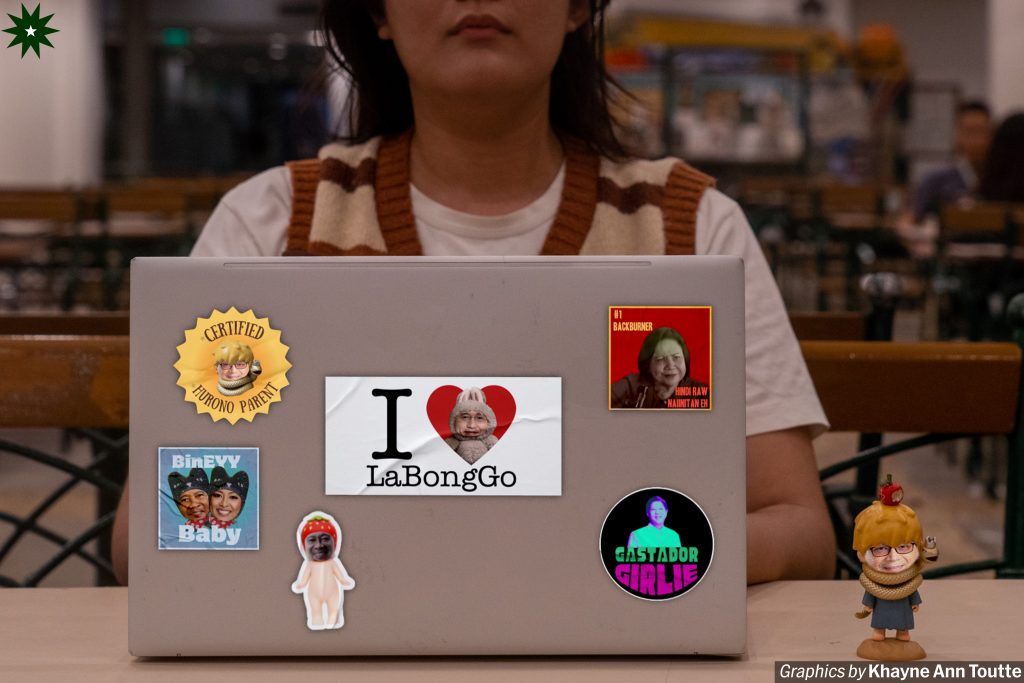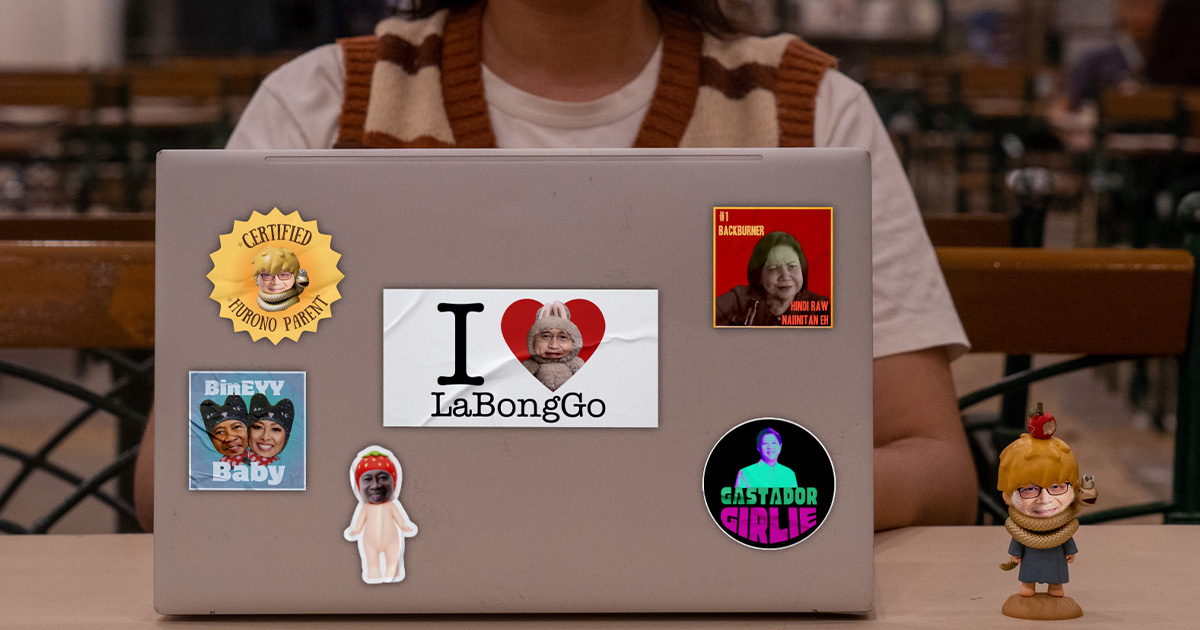With the help of their campaign managers, senatorial candidates have stationed pop-up booths around campus to hand out “anik-aniks,” merchandise, and other trinkets in hopes of wooing a specific voter demographic. They call this the “senatoriable” strategy.

Each booth is a carefully curated reflection of the candidates’ attempts to connect with Gen Z voters. From flashy designs to interactive displays, the stalls are strategically placed to represent each political party. Candidates who were once allies years back, coupled with their chants and promises of “unity,” now seem to be in a rift. At present, they are stubbornly staying yards apart, sneaking hateful glances at one another from afar.
And as rumors swirl and suspicions grow, there is much more to unpack behind this very unusual campaign strategy and spectacle.
The new target market
Among rows of colorful stickers, limited edition collectibles, and zany keychains are campaign teams working hard to capture the support of the Lasallian youth. Campaign manager Nikkie Siksik (‘18, POM-MKT) discusses the rationale behind such a strategy: “It’s all about keeping up with the current trends,” she says. “Nowadays, it’s rare to meet a fellow Gen Z without a laptop covered with stickers or trinkets attached to their bag.”
Indeed, the booths in CADS seem to attract a certain type of customer. The distinct noise of jingling IDs rings through the halls as ring-laden fingers delicately examine the various products for sale. From Sonny Angel-inspired figurines of senatorial candidates to the famed “Quiboloy loves you, and enough to save you” Ethel Cain sticker depicting aspirant Apollo Quiboloy, the merchandise has generated quite the buzz online, well beyond the DLSU community. Many of these social media posts focus on the humorous intent of these knick-knacks, alongside memes related to the candidates or popular song lyrics alongside their faces.
The surge in sales may also be credited to the intricate designs of each piece, inspired by the artworks one may find at any trendy art market. The politicians and their campaign teams have taken the time to hire artists and graphic designers who specialize in this particular niche; a move that has proven successful given the hype around the products.
“This is political marketing 101,” Siksik says. “People hate the old campaign posters. So we’ve had to think outside the box and find ways to be more relatable to younger voters. What do they like? How can we reach them?” And that is exactly how they’ve done it.
Collectors’ dream or nightmare?
Plagued by the FOMO (fear of missing out), some students hop on the bandwagon, flocking into the booths to check out what senatoriable merch and anik-aniks best fit their collections. What seems to be a crowd favorite is a Labubu doll likened to the face of a particular candidate, the LaBongGo. What makes this stall a hit, however, is that every purchase of the doll comes with a free pizza slice, courtesy of the candidate himself.
Following suit is another toy collectible from Benhur AbaLoss, an assortment of blind boxes called HURono. AbaLoss surely knows how to draw attention as he also hands out free passes to his photo booth featuring his face and distinctive blue polo plastered all over the printed-out photo frame.
“I think this is an amazing opportunity!” Kimmy Madrama (I, BS-MGT) exclaims with enthusiasm, sifting through the Sonny Angel-inspired BinEYY Babies. “For families like ours involved in politics, this is a chance to step up our game during campaign season. Ain’t this more creative than vote buying?”
Meanwhile, students flock toward Willie Di Mareveallame’s booth sporting a full display of Willie Cat Dolls. “Apparently, proceeds from these dolls will go to contestants of his show, Win na Will. I really love Kuya Will’s passion projects,” says Madrama while picking out iron-on patches for the miniature jackets on the dolls.
Right beside Mala Rosas’ stall, Madrama gushes over the rare vintage items and 70s surplus from her Tita Imee’s booth, Anything and Everything Minarcos. “Jusko, wala talagang pinapalampas ang pamilyang ‘to. Kahit ano na lang [nanakawin],” Deena Buquing (II, AB-CAM) utters irritably. The stall features various assortments such as Krizzy Achino’s Hermes bags, Leni Robredo’s camping chair, and Enrile’s dinosaur collectibles.
(Goodness, this family will steal literally anything and everything.)
A campaign in costumes
As the trend of collecting personalized anik-aniks slowly creeps into the political scene, the lines between satire and support only seem to get increasingly blurred. Many students continued to buzz around the booths for their latest haul, but there were also others like Buquing who simply stood by the sidelines, watchfully eyeing the scene before her with quiet disdain.
“You’d think they’d realize this is more than just an Internet trend,” she scoffs. To Buquing, the act of showcasing these memorabilia—whether it be in the form of quirky stickers and keychains—is one that tiptoes dangerously close to endorsement. After all, the humor behind these caricatured collectibles does little to mask how much the involved politicians ultimately gain from the spectacle. “It’s free advertising, ‘yan lang naman lagi ‘yon,” she defeatedly points out, while holding a BinEYY Baby that was left lying on the ground.
(It’s free advertising, that’s all it ever is.)
The irony is not lost on Buquing. Anik-aniks and stickers were once subject to online ridicule. But now, they have morphed into a bizarre form of promotion. And a common refrain still echoes among the crowd. “I only like it for its design, not the candidate!” Madrama insists while storing another handful of stickers into her tote, as though the face printed on it was anyone else but her very own tita.
Beyond the merch madness
This unforeseen anik-anik frenzy, ignited by the sudden campaign mob on campus, fell nothing short of what is expected from Filipinos and their inherent maximalist flair. Yet, in contrast to the traditional election campaigns, this makeshift market felt almost out of character—further driving home their struggle to remain relevant in the fickle landscape of Gen Z’s attention economy.
The senatoriable event was a peek into how far the politicians have gone to align themselves with the demographic of today, even at the cost of their dignity and credibility. Candidates who once commanded respect through speeches now find themselves vying for attention through self-ridiculing stickers, keychains, and limited-edition merchandise.
Nevertheless, these caricatures have made these politicians’ presence persist until today, with their faces stamped onto an entire generation’s consumerist culture. What started as a joke has once again evolved into another tool for publicity, leaving Gen Z to wonder when politics morphed into another consumable trend, with each new piece of merchandise leaving them more desensitized to the true weight of political responsibility.
This article was published in The LaSallian‘s Spoof 2025 issue. To read more, visit bit.ly/TLSSpoof2025.



